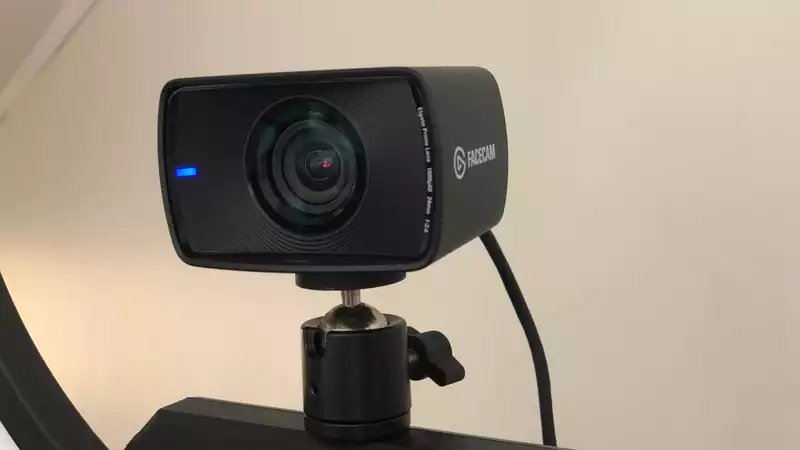Finally, Elgato's first dedicated webcam, the aptly named Elgato Facecam, was released last year with the streaming hardware company's first microphone, Wave, prompting speculation that it would be next in line for the title of best webcam. Then came the Elgato Facecam. As the name suggests, it is a webcam for your face.
Facecam is the last piece missing from Elgato's massive streaming ecosystem. This ecosystem already includes capture cards, green screens, ring lights, stream decks, microphones, and even sound panels.
Elgato's new webcam is positioned as a premium camera for streamers who want the best images, but not enough to invest in more expensive options like DSLR cameras.
Out of the box, the Facecam's image quality is excellent, but on first impression it looks a bit overexposed. However, this feels like a deliberate choice by Elgato. It appears brighter and brighter than a typical webcam, which is what most streamers want for their main shot.
Thankfully, one of the best parts of the Facecam package is the Camera Hub software. This is a simple control app that allows you to adjust camera settings in case it's not the ultra-bright look you want.
In the photo below, I adjusted the exposure so that I could actually see out the window instead of looking like my neighbor threw a flash bang into the yard. From within the bundled software, you have access to easy-to-use slider settings for FOV/zoom, exposure, image, white balance, etc.
I like photos with low color temperature, high contrast, and ring lights adding light, and Facecam's software delivers on that.
Since the Facecam is a fixed focus camera, there is no autofocus option in the camera hub. Somewhat to my surprise, it did a great job of keeping the camera in focus no matter how often I moved around or how many times I fiddled with it.
Some cameras, like the Razer Kiyo Pro, have an autofocus feature, but as soon as I lean back in my chair, I often end up with frustratingly blurry photos.
The Elgato Facecam costs $200, the same price as Razer's premium webcam, the Kiyo Pro, and the soon-to-be-released Dell UltraSharp 4K. Interestingly, all three of these webcams target different types of users and environments.
Frankly, I was surprised that Elgato made the Facecam look fairly innocuous and more like a traditional webcam. Thankfully, what this camera actually does is what makes it stand out.
The Facecam offers uncompressed video at 1080p/60fps, which is huge and may be the biggest reason streamers will want to choose it. There is no need to talk in depth about encoding and compression, but the short answer is that Facecam will give you a final video output with fewer artifacts than using most other webcams. Also, there is no need to use a program like OBS to reduce resolution or frame rate.
Elgato even solves the problem of webcams' awful sounding microphones. It simply does not have a microphone.
This is a bold move, but Elgato knows that its intended audience will rarely use a webcam's built-in microphone when streaming. If the distance from the microphone to the speakers is too far, it will pick up every sound in the room. For my part, I'm not going to mourn the loss of a crappy microphone, and if you're going to spend $200 on a new cam, you should too.
After all, there are a number of great cheap mics out there if you are willing to save a buck or two.
The omission of a built-in mic also proves that Elgato is super-targeting Facecam to streamers. Especially if you already own a pretty good microphone.
The camera itself uses Sony's STARVIS sensor, a slice of silicon traditionally used in security cameras optimized for low-light environments. I tested the Facecam in low-light settings and compared it to the Razer Kiyo Pro.
In a direct comparison of the two, the Facecam had a slight advantage when shooting in my dimly lit living room/office. The Elgato Facecam also wins in that it looks better overall compared to the Kiyo Pro's weird fisheye effect at a higher FOV. If you're still on the fence between the two, let me be clear: the Facecam beats the Razer product hands down, although I'm looking forward to seeing how Dell's 4K camera fares.
So, after a long wait, is the Elgato Facecam the best webcam out there?
I believe that honor belongs to the Logitech StreamCam. This is because the StreamCam offers more versatility for content creators and costs only $150. However, the Facecam offers the cleanest image quality I've seen in a long time and deserves top marks for that alone.
That said, I find $200 a bit too much for something that has no microphone and a conservative exterior design. I would recommend that only semi-serious streamers looking for a nice half-step before opting for a DLSR camera consider picking up a Facecam.
However, the Elgato FaceCam is a good first attempt at a webcam and a great addition to the Elgato catalog of streaming gear. It is specifically targeted at streamers who want to provide clean, low-latency video footage for broadcast if they are willing to pay a premium. But its performance is solid.
.

Comments